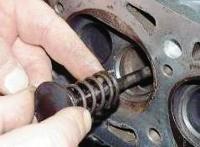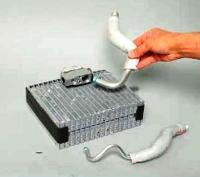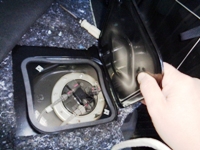You will need: 10 wrenches, Phillips and flat-blade screwdrivers, ohmmeter (autotester), test lamp

Remove the generator from the vehicle (see Removing and installing the generator).
Mark the relative position of covers 4 and 8 (Fig. 1) of the generator.

Press out the three latches.

Remove the plastic cover.

Remove the two screws securing the voltage regulator.

Remove the voltage regulator with brush holder

By disconnecting the wire from the regulator terminal.

Remove the four screws securing the rectifier unit and the screw securing the capacitor

Bend the three stator windings so that they make it possible to remove the rectifier unit

Remove the rectifier unit with capacitor.

To replace the capacitor, unscrew the nut of the contact bolt, remove the washer and spacer.
Remove the end of the capacitor wire from the terminal bolt.

Remove the four clamping screws (the screws are tightened with a large torque).
Spring and flat washers are installed under the screw heads.

Prying off with a screwdriver, remove the cover of the generator from the side of the slip rings
Clamp the generator rotor in a vise (not too hard so that the rotor does not turn) and unscrew the pulley fastening nut.
Remove the spring washer and pulley.

Remove the thrust washer.

Remove the rotor from the cover on the drive side.

Remove the distance ring from the rotor shaft.

Inspect the slip rings.
If they have scuff marks, marks, scratches, signs of wear from brushes, etc., the rings must be sanded.
If damage to the rings cannot be removed with sandpaper, you can turn the rings on a lathe, removing the minimum layer of metal, and then grind.

Check the resistance of the rotor winding with an ohmmeter (tester) by connecting it to the slip rings.
If the ohmmeter shows infinity, then there is a break in the windings and the rotor needs to be replaced.
Check with a test lamp if there is a winding short circuit on the rotor housing.

To do this, plug the test lamp into a 220 V AC mains (you can use a rechargeable battery and a 12 V lamp).
Connect one wire to the rotor body, and the second wire to each ring in turn.
In both cases, the lamp should be off.
If at least in one case the lamp is on, then a short circuit occurs and it is necessary to replace the rotor.

Inspect the stator. On the inner surface of the stator there should be no traces of armature touching the stator.
If there is wear, it is necessary to replace the bearings or generator covers
Check for an open in the stator winding.

To do this, plug the test lamp into a 220 V AC mains (you can use a rechargeable battery and a 12 V lamp).
Alternately connect a test lamp between all winding leads.
In all three cases, the lamp should be on.
If the lamp does not light up, there is a break in the winding. Replace the stator or winding.
Check for a short circuit between the stator windings and the case.

To do this, plug the test lamp into a 220 V AC mains (you can use a rechargeable battery and a 12 V lamp).
Connect the lamp to the stator winding terminal, and the wire from the current source to the stator housing. If the lamp lights up, then there is a short circuit: it is necessary to replace the stator or winding.
Inspect the drive end cover of the alternator complete with bearing.
If during rotation of the bearing you feel play between the rings, rolling or jamming of the rolling elements, damaged protective rings or there are traces of lubricant leakage, and cracks are found in the cover, especially in the places where the generator is attached, it is necessary to replace the cover assembly with the bearing (bearing in lid is rolled).
Check the ease of rotation of the bearing on the side of the slip rings.
If during rotation of the bearing there is play between the rings, rolling or jamming of the rolling elements, the protective rings are damaged or there are traces of grease leakage, the bearing must be replaced.
To do this, use a puller to press the bearing off the rotor shaft and press on a new one using a suitable mandrel, applying force to the inner race of the bearing.
Inspect the generator cover from the side of the slip rings. If cracks are found, the cover must be replaced.
Check check the voltage regulator.
Check the condition of the capacitor.
Damage of the capacitor or loosening of its fastening on the generator (deterioration of contact with the ground) is detected by an increase in radio interference with the engine running.
The capacitor can be checked with a megger or tester. If there is no break in the capacitor, then at the moment the probes of the device are connected to the terminals of the capacitor, the arrow should deviate in the direction of decreasing resistance, and then gradually return back.
You can check the rectifier unit both on the removed generator and without removing the generator from the car.
The order of checking is the same. For clarity, the verification schemes are shown on the removed generator.
To check on the car, disconnect the wires from the battery and the generator, and also remove the block with the wire from the voltage regulator terminal.

Remove the brush holder from the generator.
Check the rectifier diodes with a 12 V test light and battery.

To check the short circuit in the positive and negative diodes, connect the "+" of the battery through a test lamp to the "B +" terminal of the generator, and the "-" of the battery to the generator case.
The lamp should not be on: if it is on, then there is a short circuit.
The block needs to be replaced.

To check the positive diodes, connect the “+” of the battery through a test lamp to the “B+” terminal of the generator, and the wire coming from the “-” of the battery to one of the screws securing the stator winding output.
The lamp should not burn: if it is on, then there is a short circuit in the positive diodes.
The block needs to be replaced.

To check the negative diodes, connect the "+" of the battery through a test lamp to one of the screws securing the stator winding output, and the wire coming from the "-" of the battery to the generator housing.
The lamp must not be lit; if it is on, then there is a short circuit in the negative diodes.
The block needs to be replaced.

To check additional diodes, connect the "+" of the battery through a test lamp to the contact of the connecting block of the voltage regulator, and the wire coming from the "-" of the battery to one of the screws securing the stator winding output.
The lamp must not be lit; if it is on, it means that there is a short circuit in the additional diodes.
The block needs to be replaced.
Reassemble the alternator in the reverse order of removal.
In this case, orient the generator covers in accordance with the marks made earlier.
Install the spring washer of the alternator pulley with the convex side to the nut.
Tighten the nut to 39-62 Nm (3.9-6.2 kgf).











